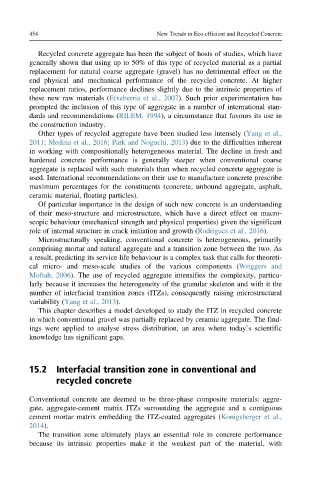Page 504 - New Trends in Eco efficient and Recycled Concrete
P. 504
454 New Trends in Eco-efficient and Recycled Concrete
Recycled concrete aggregate has been the subject of hosts of studies, which have
generally shown that using up to 50% of this type of recycled material as a partial
replacement for natural coarse aggregate (gravel) has no detrimental effect on the
end physical and mechanical performance of the recycled concrete. At higher
replacement ratios, performance declines slightly due to the intrinsic properties of
these new raw materials (Etxeberria et al., 2007). Such prior experimentation has
prompted the inclusion of this type of aggregate in a number of international stan-
dards and recommendations (RILEM, 1994), a circumstance that favours its use in
the construction industry.
Other types of recycled aggregate have been studied less intensely (Yang et al.,
2011; Medina et al., 2016; Park and Noguchi, 2013) due to the difficulties inherent
in working with compositionally heterogeneous material. The decline in fresh and
hardened concrete performance is generally steeper when conventional coarse
aggregate is replaced with such materials than when recycled concrete aggregate is
used. International recommendations on their use to manufacture concrete prescribe
maximum percentages for the constituents (concrete, unbound aggregate, asphalt,
ceramic material, floating particles).
Of particular importance in the design of such new concrete is an understanding
of their meso-structure and microstructure, which have a direct effect on macro-
scopic behaviour (mechanical strength and physical properties) given the significant
role of internal structure in crack initiation and growth (Rodrigues et al., 2016).
Microstructurally speaking, conventional concrete is heterogeneous, primarily
comprising mortar and natural aggregate and a transition zone between the two. As
a result, predicting its service life behaviour is a complex task that calls for theoreti-
cal micro- and meso-scale studies of the various components (Wriggers and
Moftah, 2006). The use of recycled aggregate intensifies the complexity, particu-
larly because it increases the heterogeneity of the granular skeleton and with it the
number of interfacial transition zones (ITZs), consequently raising microstructural
variability (Yang et al., 2013).
This chapter describes a model developed to study the ITZ in recycled concrete
in which conventional gravel was partially replaced by ceramic aggregate. The find-
ings were applied to analyse stress distribution, an area where today’s scientific
knowledge has significant gaps.
15.2 Interfacial transition zone in conventional and
recycled concrete
Conventional concrete are deemed to be three-phase composite materials: aggre-
gate, aggregate-cement matrix ITZs surrounding the aggregate and a contiguous
cement mortar matrix embedding the ITZ-coated aggregates (Konigsberger et al.,
2014).
The transition zone ultimately plays an essential role in concrete performance
because its intrinsic properties make it the weakest part of the material, with

